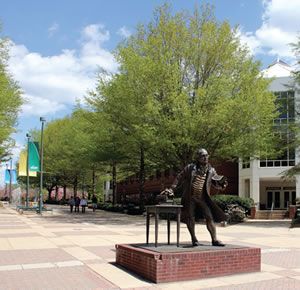George Mason University
Project Snapshot
PROJECT:
Security Upgrades
INSTITUTION:
George Mason University
LOCATION:
Fairfax, VA
COMPANY NAME:
HID Global
WEBSITE:
hidglobal.com

As the commonwealth of Virginia’s
largest public university, George
Mason University has a population
of more than 35,000 students, faculty
members and contractors. The
university needed a cost-effective
migration plan to replace its outdated
and vulnerable ID card system.
THE CHALLENGE
For over a decade, George Mason University has issued
magstripe ID cards that not only wore out quickly, but relied
on older security technology that lacked the cryptographic
capabilities of smart cards, making them susceptible to
cloning and counterfeiting. It was also difficult to update and
manage old campus door locks and cards.
Greater campus security could be achieved by moving to
a new contactless smart card technology, but the greatest
efficiency and convenience would come from leveraging the
power of a flexible, “one card” solution that enabled the Mason
ID to be used with not only access control systems, but other
value-added applications and services on and off campus.
THE SOLUTION
By working with HID Global and its parent company
ASSA ABLOY, George Mason was able to design a cost-effective
and comprehensive ID solution that would enable university
administrators to migrate their existing card system. Simultaneously compatible with the legacy student ID cards
and the existing hardware on campus, this new solution
would be deployed slowly and consist of the following: HID
Global multiCLASS SE readers, as well as PERSONA Campus™
Software, and SARGENT Passport locks from HID Global’s
parent company ASSA ABLOY provide built-in encryption and
enhanced security.
 Seos smart cards from HID Global deliver advanced
security, interoperability between the new locks and readers
and multiple card applications enabled by its breakthrough
technology leveraging HID Global OMNIKEY® desktop readers
to extend the Seos card’s use.
Seos smart cards from HID Global deliver advanced
security, interoperability between the new locks and readers
and multiple card applications enabled by its breakthrough
technology leveraging HID Global OMNIKEY® desktop readers
to extend the Seos card’s use.
Powered by Seos smart card technology, the new George
Mason ID cards are initially being used for accessing facilities,
residence halls, library and cafeteria services. To date, George
Mason has installed approximately 3,500 new locks and
readers and has issued more than 12,000 new ID cards to
incoming freshmen.
 IMPACT ON LEARNING
IMPACT ON LEARNING
The university now has state-of-the-art facility
security as well as real-time control when a lock-down or
other changes are needed. They also can quickly and easily
modify their access control system, including updating card
privileges, revoking or replacing lost/stolen cards and adding
or removing applications.
The move to a Seos-based technology solution has
provided the university with more freedom of choice and the
ability to add more applications as it scales in the future, while
providing the confidence that the university is receiving the
best-in-class security and privacy protection for its students
and staff. Giving students a safe place to live and learn are two
key components in creating a great educational experience.
Editor’s Review
Studies have shown
that students learn more
effectively in environments
that they perceive to be
safe and secure. Ensuring
that a campus has in place
an up-to-date, integrated
security system and puts
into students’ hands an ID
card that is linked to the
system and admits them
(and only them) into the
appropriate campus facilities
is visible reassurance
that the university is taking
safety seriously.
This article originally appeared in the issue of .